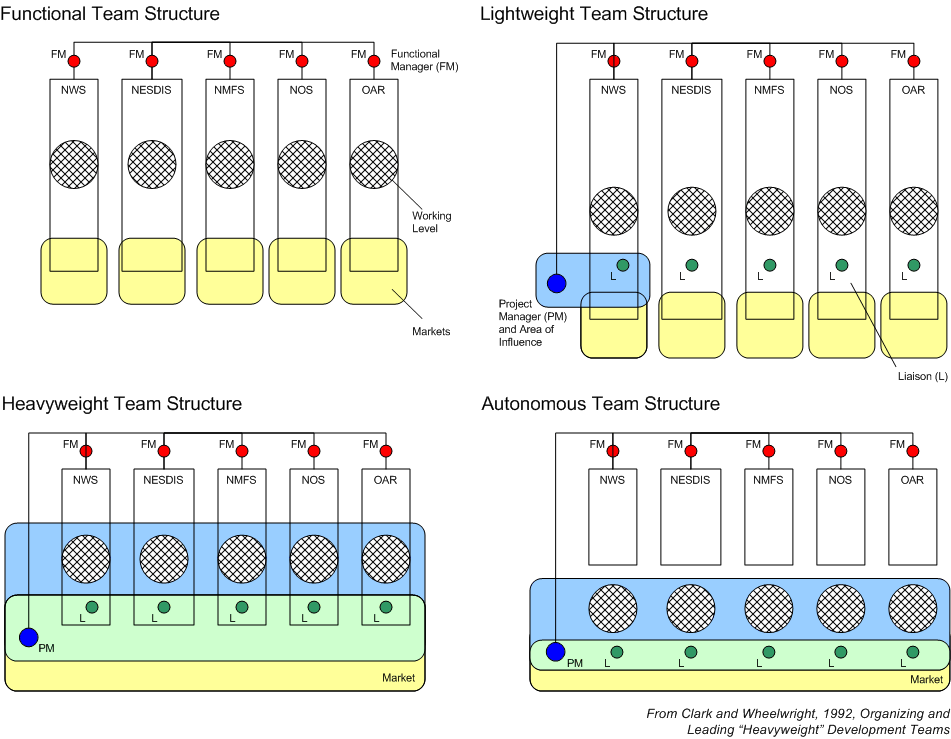Creating Consistently Effective Teams
From Leading Product Development: The Senior Manager's Guide to Creating and Shaping the Enterprise, Steven Wheelwright and Kim Clark, The Free Press, New York, NY 1995
Senior Management Activities to Make Teams Work
- Define project boundaries, mission, and charters
- Matching the project type to the team type
- Creating job opportunities and career paths that result in qualified team leaders and core team members
- Ensuring that functions build capabilities so that teams have the right knowledge, tools, and other resources.
- Ensuring that the actions of teams are not only effective in achieving individual project goals, but also fit well with the overall strategy of the business
- Supporting the team with unforeseen contingencies
- Ensuring that there is a seamless transition of responsibility to the operational team when the project is done.
Stages of Functions Within an Organization
1) Minimize negative potential - be internally neutral
Puts function in narrow, operating role with no influence on strategic decisions. The people running the function are not real players and career opportunities rarely extend beyond the function.
2) Match competitors - be externally neutral
Use normal or standard industry practices to guide and gage the progress of the function.
3) Back the strategy - be internally supportive
The function makes decisions in the light of the business strategy and strives to provide credible support to key business objectives.
4) Support a distinctive, sustainable advantage - be externally supportive
Function recognized and valued as a source of competitive advantage by customers and other functions; its capabilities help distinguish the business from its rivals. Senior managers, as a team of peers, shape the business strategy to exploit the functions capabilities. The people running the function understand their strategic role, seek to identify longer-term trends and opportunities, and build capability in anticipation of strategic needs.
In a Stage 4 Enterprise each function is a source of competitive advantage, the advantages created are complementary and reinforcing, and the heads of all functions are key players on the senior management team.
The goal is to create a stage 4 senior management team, even if the functions are not there yet. Stage 4 individuals are proactive in their approach, always looking for good ideas and better ways to do things in order to take the business forward. They are a great asset to the senior management team and an outstanding role model for the people in the functions.
Types of Project Teams
Different types of projects require different type of teams. Four types of teams have been identified. Key differences are the role of the team leader, the commitment of those doing the work, and who controls and allocates critical resources.
Functional Teams - found most often in mature organizations, organized by functions, under the direction of specialized department manager and a senior functional manager. Each function owns the work processes it uses and seeks to apply them in a fairly uniform way, independent of the specific project and its nature. Responsibility for project work shifts from function to function over time according to agreements as to who controls what, a process that does not always run smoothly or quickly.
Lightweight Teams – characterized by functional representatives – liaisons – who comprise a committee, directed, (or, more descriptively, coordinated) by a lightweight project manager that attempts to schedule, encourage, and track the project’s various activities. The basic work and the bulk of the decision making take place back in the functions, and the functional representatives remain part of their disciplines, with the liaison role added to their regular responsibilities.
The lightweight manager has expertise in his or her function, but no status or influence; … The “lightweight” designation also implies the manager’s lack of control over resources (including people), which remain within the responsibility of the functional areas. Thus, while lightweight managers coordinate project activities, … they can neither reallocate resources nor reassign people within the project. Typically, these managers spend about 25% of their time in this role and describe their key activities in terms such as “reminding”, “encouraging”, “persuading”, and “pleading”.
Heavyweight Teams – give the heavyweight project leader responsibility for the total project effort and its overall success. This includes integrating functions and bringing the “voice” of the customer into the process. The heavyweight leader is often quite senior in the organization, and brings both expertise and organizational clout to the project. The heavyweight team itself consists of a core group of functional leaders responsible for work on the project and the majority of project decisions in their functions. While much of the work goes on in functional groups, it goes on under the direction and influence of the heavyweight team and its leader.
Autonomous Teams – or “tiger teams”, are heavyweight teams whose members have been pulled out of the functions and transferred to the project. In their pure form, team members are co-located (as is usually the case with heavyweight teams) and self-contained.
Strengths and Weaknesses
| Team Type | Strengths | Weaknesses |
| Functional | Optimal use of resources, expertise, depth, scale economies; control and accountability; career path congruence. | Lack of breadth; rigid, bureaucratic; task- not project-oriented; slow, disjointed; turf/expertise- driven. |
| Lightweight | Improved communication and coordination; less idle time between tasks | Weak project leader and project focus; frustrating to individuals |
| Heavyweight | Strong project focus, commitment and accountability; integrated system solution | Hard to staff; requires breadth; must break down functional barriers |
| Autonomous | Focus on results; owns business objectives; innovative | Independent/not integrated with rest of organization; autonomy is core value |
